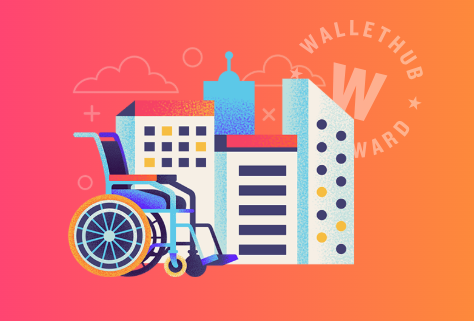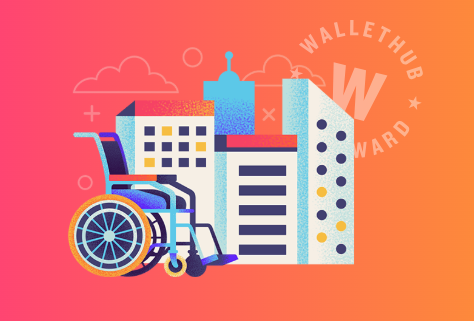With October being National Disability Employment Awareness Month and the average monthly Social Security disability benefit at only $1,445.72, barely enough to keep an individual out of poverty, the personal-finance company WalletHub has released its report on 2025’s Best & Worst Cities for People with Disabilities, as well as expert commentary.
Four Arizona cities were in the top 10, while one California city – Huntington Beach – also was rated among the best.
In order to ease the process of finding the best place to live while managing a disability, WalletHub compared more than 180 U.S. cities across 33 key indicators of disability-friendliness. The data set ranges from wheelchair-accessible facilities per capita to the rate of workers with disabilities to the quality of the public hospital system.
Best Cities for People With Disabilities
Minneapolis, Minnesota was the top city in the study, followed by St. Louis, Missouri at number two. They were followed by Scottsdale, AZ; Columbus, OH; St. Paul, MN; Chandler AZ; Peoria, AZ; Pittsburgh, PA; Gilbert, AZ; and, rounding out the top 10, Huntington Beach, CA.
Worst Cities for People With Disabilities
At the bottom of the list, Shreveport, Louisiana came in at number 173, followed by New Haven, CT; Mobile, AL; Montgomery, AL; Burlington, VT; Jackson, MS; Pearl City, HI; Gulfport, MS; South Burlington, VT; and ranked last, at number 182, was Juneau, Alaska.
Best vs. Worst
Fort Smith, Arkansas, has the highest share of people with disabilities living in the area, which is 3.7 times higher than in Irvine, California, the city with the lowest.
Plano, Texas, has the lowest share of people with disabilities living in poverty, which is 4.3 times lower than in Cleveland, Ohio, the city with the highest.
Columbus, Ohio and Laredo, Texas, have the lowest median annual cost of in-home services, which is 3.9 times lower than in Cheyenne, Wyoming, the city with the highest.
Fremont, California, has the highest median annual earnings for people with disabilities, which is 8.3 times higher than in Burlington, Vermont, the city with the lowest.
“More than one in four U.S. adults live with a disability, so it’s extremely important for cities to prioritize becoming a safe, welcoming and affordable place for this demographic. The best cities have highly-accessible public facilities and housing, high-quality medical care, and an affordable cost of living for people on a fixed income,” said Chip Lupo, WalletHub Analyst. “Minneapolis, Minnesota, is the best city for people with disabilities, in part due to the availability of affordable, quality medical care. The average monthly health insurance premium in Minneapolis is $355, the second-lowest in the country. In addition, the city has the eighth-best public hospitals and the 11th-most hospitals per capita.”
To view the full report, visit: https://wallethub.com/edu/best-worst-cities-for-people-with-disabilities/7164
Expert Commentary
What are the unique financial challenges faced by people with disabilities, particularly those who rely on government assistance? How can these challenges be overcome?
“Asset and income limits that are placed on receipt of some government assistance programs (such as SSI) are a huge barrier to work. Essentially, these limits mean that many people with disabilities must limit their working hours, take jobs for lower pay than they are qualified for, and cannot save for emergencies. And, since asset limits are based on household income, the limits can pose a barrier to normal life events, such as marriage. Advocates are currently trying to get these asset and monthly income limits raised to a more reasonable level. So, people with disabilities can live a life like yours.”
Matthew Bogenschutz, Ph.D. – Associate Professor; Director, Virginia LEND, Partnership for People with Disabilities, Virginia Commonwealth University
“Aside from its other impacts, having a disability can be expensive both in terms of money spent on things like doctors’ bills, therapies, aides, and equipment and money lost due to having to miss work to care for yourself or a loved one. The benefits available for dealing with disabilities can be generous but complicated, and one missed deadline or poorly written report can be costly. Furthermore, there are often limitations on how much income you can have on hand while remaining eligible for needed benefits. There are resources available, and tools like an ABLE Account or a Special Needs Trust can help a person work around some of the restrictions in order to have the resources they need to live a full life, but you really need to know the ins and outs of these tools and programs (or find someone who does) to make sure you don’t put your overall financial health in jeopardy.”
Stephen Glicksman, PhD. – Developmental Psychologist; Director of Innovation, Makor Care & Services Network; Adjunct Associate Professor, Yeshiva University
The Americans with Disabilities Act (ADA) was adopted over three decades ago. What 21st-century improvements should be made, if any, to this important act?
“So many. While the ADA was incredible and so needed when it was adopted, what many people do not realize is that it neither has funding nor teeth. What this means is that if somewhere is inaccessible, like an older building, the ADA does not come with any funds to add access. Therefore, it does not encourage businesses, public facilities, etc., to update towards accessibility preemptively; rather, it encourages them to wait for a complaint or lawsuit, which puts the onus of accessibility on people with disabilities. Moreover, there is no portion of the ADA that does evaluation, recommendations, etc. – it relies primarily on schools, businesses, etc., to figure things out on their own, or to wait to be sued for lack of access. Also, religious facilities are completely exempt, so despite having non-profit status and not paying taxes, they do not have to make their churches, temples, mosques, etc., accessible. Improvements should increase the number of things included under the ADA, add an evaluation and support component, and earmark funding to help spaces improve their accessibility proactively.”
Shanna K. Kattari, PhD, MEd, CSE – Associate Professor, University of Michigan
“The ADA is still a model for anti-discrimination policy around the world. However, it has never had an enforcement mechanism, meaning that a person with a disability often must threaten a lawsuit and be able to prove discrimination in order to get their needs met. This is obviously not just, and means that discrimination is most often not addressed. Adding a formal enforcement mechanism to hold employers, schools, landlords, etc. accountable for accessibility would be a major advance for disability rights.”
Matthew Bogenschutz, Ph.D. – Associate Professor; Director, Virginia LEND, Partnership for People with Disabilities, Virginia Commonwealth University
What can be done to facilitate better access to health care for people with disabilities?
“Having more health care providers, from primary care providers to specialists, so that wait times are shorter, and having patient navigators with knowledge around disabilities and ableism available to help find providers who take specific insurance, Medicaid, etc. Support for telehealth across all types of providers, not just mental health. Ensuring facilities are more accessible, as in not just ramps and parking spaces, but raising and lowering exam tables, sensory-friendly lighting, screen reader-friendly forms (not just paper forms), etc. Integrative health care practices where one can have a PCP, a therapist, and even get dental care, help filling out forms for SNAP and other services as needed (perhaps with case managers). Recruiting providers that have special interests in or training around disability, and funding centers that support disability health research and practice. Having local accessible rides to health care services for all people with disabilities, not just those who have certain governmental benefits.”
Shanna K. Kattari, PhD, MEd, CSE – Associate Professor, University of Michigan
“So much! Most healthcare providers are not trained to serve people with disabilities, so more specialized training opportunities are necessary. Many people with disabilities rely on Medicaid, which reimburses providers poorly for some services, so some providers will not accept people with disabilities who use Medicaid. Adjusting reimbursement rates would be a useful solution. Improving transportation, including both public transportation and paratransit would help people with disabilities get to and from appointments reliably. And so much more…”
Matthew Bogenschutz, Ph.D. – Associate Professor; Director, Virginia LEND, Partnership for People with Disabilities, Virginia Commonwealth University





